ENGINEERINGNET.BE - De auteur Daan Moreels gaf ons in primeur de toestemming om dit witboek online te publiceren. Hieronder kan u het Engels artikel volledig lezen.
White paper: High efficiency axial flux machines
The world is moving away from carbon-based energy generation and consumption, towards an increasingly electrified paradigm. Electric machines (generators and motors) are ubiquitous, the cornerstones of the modern world and the transition to a low-carbon economy. Turbines dominate electrical power generation. At present, 45% of electricity consumption comes from electric motors and this figure is constantly rising, while 70% of industrial electricity usage is accounted for by industrial motors.
The impact of electrical machines’ performance on all aspects of energy, from cost-effectiveness to environmental footprint, cannot be overstated.
Today, however, most motors and generators are built on a combination of induction motors and gearboxes – mature technology that has peaked at an average worldwide efficiency of 84% to 90%. Better electric generation or drive trains require more advanced, direct-drive designs, but traditional direct-drive solutions (without gearboxes) suffer from problems with machine cost and size. The shortcomings of existing machines are particularly clear in mass- or volume-constrained implementations (wind turbines or wave energy converters), or in all-electric drive trains (electric vehicles).
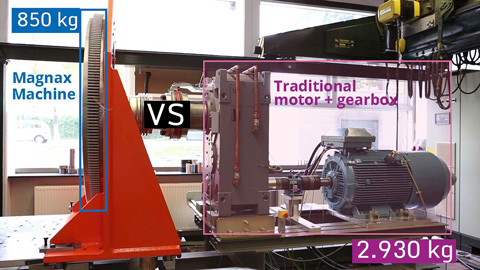
The Innovation
With regard to electrical motor technology, one particular type of electrical machine demonstrates superior characteristics: the axial flux permanent magnet machine. Axial flux permanent magnet machines perform excellently at a very broad range of rotational speeds, which makes them perfectly suitable for high-speed-low-torque as well as low-speed-high-torque applications.
Moreover, axial flux permanent magnet machines are significantly compact; the axial length of the machine is much smaller compared to radial machines, which is often crucial for built-in applications. The slim and lightweight structure results in a machine with a higher power and torque density. Finally, but very important in terms of the focus of this work: Axial Flux Permanent Magnet (AFPM) machines can attain the highest energy efficiency of all electrical machines.
Magnax, a technology company from Belgium, has developed a unique machine concept, based on the AFPM topology. These High-Efficiency Axial Flux (HEAF) machines have substantial advantages over other existing state-of-the-art generators or motors (figures given here are indicative for a 100kW generator machine):
- Increased efficiency (96% to 98% efficiency vs. typical industry values of 84 to 92%).
- Reduced length (5 to 8 times shorter than traditional motors/generators).
- Reduced mass (2 to 5 times lighter than geared or traditional direct-drive machines).
- Reduced resources requirement (½ to ? of materials required vs. other machines).
- Improved reliability (no gearbox).
The Magnax HEAF concept attains these vastly superior characteristics by enabling the combined use of the following best-in-class practices into one machine, a feat which has thus far been impossible using known machine concepts:
- Dual permanent magnet rotors, for the highest possible torque-to-weight ratio.
- Yokeless stator, for the shortest possible flux paths.
- Rectangular section copper wire, for the highest possible copper fill factor (90%).
- Concentrated windings, for the lowest possible copper losses (no coil overhangs).
- High-performance grain-oriented electrical steel (ThyssenKrupp GOES), lowering the core losses by as much as 85%.
- A patented system for cooling the windings, for the lowest possible stator temperatures.
- The entire manufacturing chain is based on low-cost, easy-to-scale production processes.
The Direct-Drive Concept
Electric machine solutions are currently dominated by combinations of standard induction motors and gearboxes. The figure above shows a typical induction motor/gearbox (I+G) combination, and the equivalent gearbox/generator combination found in a utility scale wind turbine. These solutions have a maximum efficiency typically below 90% at full load, and lower at partial loads.

They also often result in long, massive, drive trains. Although relatively inexpensive to buy (lower capital expenditure, CAPEX), these solutions always require a certain maintenance (increased operational expenditure, OPEX, and lower lifespan). For example, one study concludes that up to 25% of an offshore wind farm’s maintenance costs were related to gearbox failures.
Reliability is an important issue in most applications: Performing maintenance on wind turbines, for instance, is difficult and expensive, which is compounded for offshore installations. For industrial process installations (e.g. plastic extruders), shutdowns due to failure or maintenance are less and less acceptable. Limited reliability renders systems are increasingly less interesting for a growing number of applications. At the same time, consumer and regulatory demands keep pushing for increasingly higher performance – primarily efficiency – for motors and generators.
Since 2000, we have witnessed an evolution in the direction of motors and generators fitted with permanent magnets in the rotor (usually referred to as Permanent Magnet Synchronous Machines PMSM). In any motor, interaction of the magnetic fields of the rotor and the stator create the rotational force that drive the machine.
Permanent magnets generate a constant magnetic field and thus generate a flux by design. As a result, the power density and dynamic performance of PMSM machines is higher compared to induction machines or electrically excited machines, where this magnetic field must be created (directly or indirectly) via an electrical current.
Radial-flux (RF) direct-drive (DD) machines are an alternative solution to overcome the issues with efficiency and reliability of traditional (I+G) solutions associated primarily with gearboxes. Here, the gearbox is removed entirely, with the generator or motor coupled directly to the load. For this solution to be effective, the motor/generator needs to be able to supply the required drive torque directly, and at low speed, which requires an entirely new motor/generator design.
Examples of RF DD machines can be found, for example, in some recent washing machines, through to the largest class of wind turbines from Siemens and General Electric (developed following heavy R&D investment since 2010).
These machines are generally more efficient and reliable than I+G combinations, to the extent that they are the only viable solution in many applications, such as offshore wind generation. However, RF DD machines are generally larger, heavier and more expensive than I+G solutions with the same power rating.
The reasons why RF DD machines are heavier and more expensive is due to the use of radial magnetic flux to transfer power. Fundamental electromagnetic and thermal constraints with this approach result in machines that are often both wide and long, compared to state-of-the-art models in I+G. Large machines require in turn a large amount of resources: rare-earth metals for strong permanent magnets and copper for the coils. It is the use of rare and valuable resources which has a huge impact on the cost and environmental footprint
(life cycle analysis) of RF DD machines.
Introduction of Axial Flux (AF) Direct Drive (DD) machines
A fundamentally different approach to direct drive is to put two sets of magnets parallel to each other, perpendicular to the axis of rotation. Figure 4 shows the basic differences in geometry. This Axial Flux (AF) topology allows machines that are much less wide and less heavy than RF DD machines. As well as being more compact, AF DD machines can reach higher efficiencies than RF DD machines, which has been verified in multiple experiments.
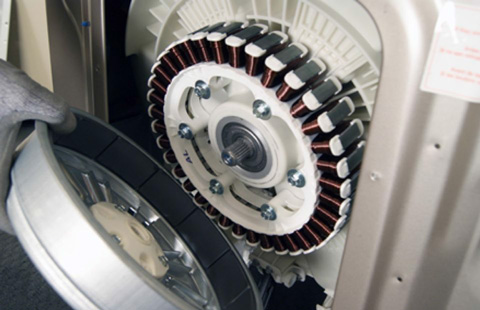
Why axial flux machines have the highest power density and efficiency
As previously stated, most of the Permanent Magnet machines used today work with a radial flux topology. In this case, the flux loop starts at a first permanent magnet on the rotor, then passes through a first tooth on the stator, then flows radially along the stator, then passes through a second tooth, to finally arrive at the second magnet on the rotor.
In comparison with the axial flux topology, the flux loop starts at a first magnet on the rotor, then passes axially through one stator tooth, and immediately arrives at the second magnet. So it is clear that, in axial flux machines, the flux path is much shorter compared to radial flux machines. This results in a higher power density and efficiency.
Why are not all machines axial flux machines?
Historically, Axial Flux designs have posed some serious design and production challenges.
- Mechanical challenges: the high magnetic forces acting between the rotor and the stator produces an engineering and material challenge in maintaining a high-tolerance uniform air gap between these two components.
- Thermal challenges: windings in an axial flux machine are located deep within the stator and between the two rotor discs – which presents a greater challenge in terms of cooling than for an RF DD design.
- Manufacturing challenges: AF machines have thus far been very difficult to manufacture because the design of the stator iron has continued to be based on that of an RF machine, using a stator yoke to close the flux loop. This design is well-tried and tested for RF DD and is based largely on the same principles as for I+G systems, meaning it is easy to manufacture. In AF topology, however, this results in a far more complicated stator than for an RF system, making automated production and achieving volume scaling savings extremely difficult. These challenges translate to cost and very poor scaling, which is the reason most direct drive generators and motors today are based on Radial Flux. There are however a few large volume deployments of AF technology, where the high manufacturing cost and low specific power are overridden by other advantages such as size: Kone, for example, uses the AF topology in their ‘Ecodisc’ elevator motors, where the size advantage enables the elimination of a machine room.
Some alternative topologies attempt to fundamentally address these issues:
one alternative, the Coreless AF Topology, addresses the challenges of AF machines by removing the entire stator iron. However, the lack of a stator iron requires the machine to have a much larger diameter and much more permanent magnet material. Not only does this significantly increase size and weight, it results in a prohibitively high magnet cost. This remains a popular and viable solution for very low-power applications, such as DIY wind turbines and off-the-grid solutions, but it does not scale commercially – as Boulder Wind Power (Colorado, USA), and NGenTec (Glasgow, UK), who both pursued this solution but who recently went out of business, discovered.
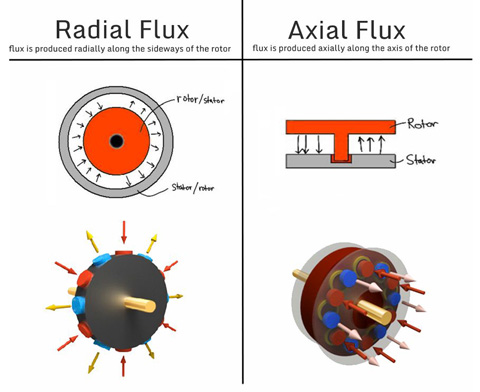
Description of the solution as developed by Magnax
A second alternative is the Yokeless AF Topology. In this case, only the iron yoke of the stator is removed, but the iron teeth are kept. This overcomes some of the problems with AF whilst avoiding the need to scale the machine diameter and magnets. It is the only AF topology to be successfully commercialised to date by Magnax (Belgium) and Yasa Motors (UK). Removing the yoke, however, introduces new challenges: how to fix and position individual teeth without a yoke connection (mechanical) and a greater thermal challenge. YASA uses complex methods to overcome these challenges which result in expensive products that are difficult to scale in both size and production volume. Furthermore, using SMC cores (soft magnetic composite) is very difficult to subcontract and scale.
Ghent University has been working on these specific challenges since 2008 and Magnax has benefited from several years of R&D to develop a better version of yokeless axial flux machines and manufacturing methods. These machines can be manufactured on a large scale using established manufacturing techniques.
Magnax introduces a fundamentally new -patented- technology, accelerating Yokeless AF Topology beyond the current state-of-the-art model. The Magnax AF DD machines overcome mechanical, thermal and manufacturing challenges, resulting in machines which are not only relatively easy to manufacture, they also combine proprietary solutions in resource usage, modularity and suitability for highly automated manufacturing.
In the summer of 2017, Magnax showcased the first prototype of a 100-kW AF generator (as shown on page 2). This 100-kW generator is smaller, lighter and more efficient than the best I+G and radial flux direct-drive PM (RF) machines. As an example, the prototype weighs about 850 kg while I+G and RF version of the same power/torque typically weigh about 2 to 6 tons. Compared to other Yokeless AF machine concepts, this concept is also more flexible, robust and modular which offers huge possibilities in terms of production scaling and cost-effectiveness.
Rotor and Stator
The Magnax axial flux machine consists of a stator and two rotor discs where the stator is located between the two rotor discs. So there is a small air gap between rotors and stator. The stator contains the windings and the rotors contain the magnets.
With regard to the attraction force between the two rotor discs and the stator:
the two rotor discs exert an equal (but opposite) attraction force on the rotor. The discs, however, are directly connected to each other via the shaft ring, so the forces cancel each other out.
Hence, the internal bearing does not carry these forces, it only needs to keep the stator in the middle between the two rotor discs. Theoretically, when the stator is exactly in the middle, it is in equilibrium and no forces act upon the bearing (but in reality, this is not achievable; so a small force will always act upon the internal bearing).
Flux efficiency
The Magnax Axial Flux machines use ThyssenKrupp’s high-performance Grain-Oriented electrical steel (GOES) for its cores. Grain-oriented steel cannot be used with RF machines because the flux paths in these machines follow a non-linear 2D path. In the Magnax axial flux topology, the grains of the steel are oriented in the same direction as the flux paths. The advantageous low losses and excellent permeability of the grain oriented material in the rolling (axial) direction results in a machine with 85% reduced stator core losses and a slight increase of the electromagnetic torque.
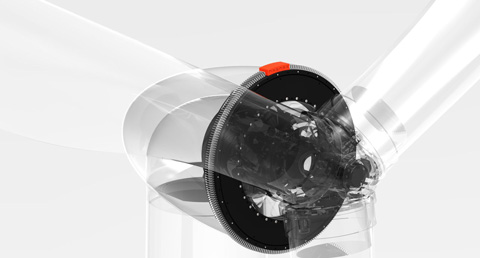
Efficiency curves
The figure compares efficiencies for wind turbine applications using Induction Generator + Gearbox, Permanent Magnet Generators and Magnax AF DD technologies. Not only does Magnax achieve a higher peak efficiency at rated load, it retains a higher efficiency at partial loads – the regime at which e.g. wind turbines operate at most times.
Modular design (multi-stator topology)
Since the length of the machines is very short (140 mm for a 100-kW model for instance), multiple machines (discs) can work in parallel. We call this the multistator topology. This is usually done when the outside diameter of the generator - or motor assembly - must be kept limited. Combining multiple machines in one stack gives a lot of flexibility to the end-user application and allows a more “standardized” engineering approach. This configuration allows fault tolerance as the machine can keep working even if any of the stages is damaged or disconnected.
To reduce the axial length and weight even more. Back-to-back rotors can be combined into one while internal bearings can be replaced by one or two external bearings.
Magnax Axial Flux Machines - Development History
The Magnax axial flux machine has a yokeless topology. Development of this topology goes back to 2008 when Ghent University started researching this method. A first proof of concept was created in 2009 and the concept was heavily researched by Ghent University over the following years. The first viable prototype operated successfully when Magnax added specific development and engineering skills to develop the 4-kW prototype.
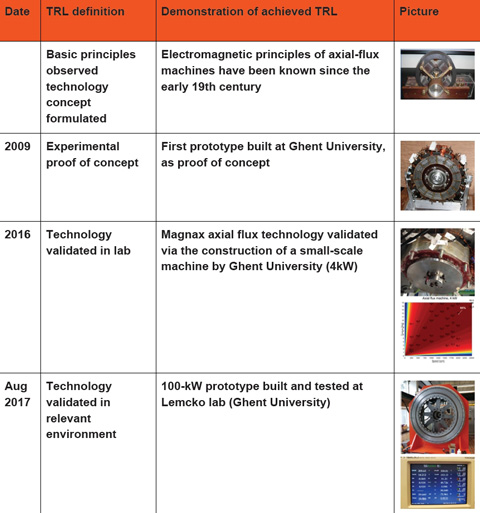
Overview of the motor / generator technologies for high torque - low rpm direct-drive applications.
The table below compares Magnax AF DD machines with other technology, for a 100-kW 60 rpm generator/motor, with a constant 16 kNm of torque.
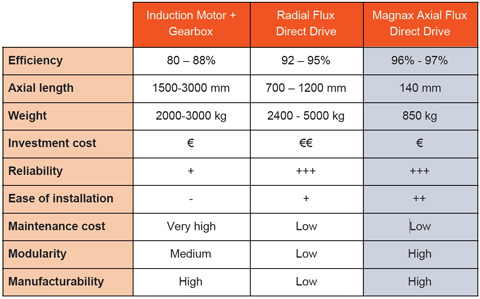
Who is Magnax?
Magnax (a contraction of Magnetic Axial) was founded in April 2015 by industrial designer Peter Leijnen.
Peter realised that only a new type of machine, based on axial flux topology, could meet the evolving and increasing requirements of developers in the wind power industry. Ghent University (UGent) had been executing specialised research into axial flux technology for many years, but had not overcome some of the engineering challenges necessary to create a cost-effective, commercial device.
Peter combined his 20 years of engineering experience with Ghent University’s research expertise to design and build 4-kW and 100-kW prototype of a new generation of axial flux direct drive machines. The 100-kW full-scale machine, successfully demonstrated this summer 2017, delivered the concept of a new type of machine for wind turbines, able to deliver significant advantages in terms of weight, efficiency, reliability and cost. The 100-kW machine can also be used for other purposes, as demonstrated futher on.
Typical use cases for axial flux technology
1) High Torque - Low RPM Generator Applications
Global warming caused by the large industrial consumption of energy is one of the most significant environmental challenges on a worldwide scale. As a result, energy savings, high efficiency and recycling are becoming increasingly more important. However, with the current economic issues that surround the environment today, businesses must weigh their options with gear drives that are typically used in most industrial applications. Gearbox systems reduce efficiency with each reduction stage. Thus, one alternative is to opt for direct-drive technology which has started to penetrate the markets.
2) Wind power
Using Magnax axial flux direct-drive generators for wind turbine applications is an obvious choice when we compare its specifications with the current technologies used in wind turbines:
- Wind turbines with induction motors and gearboxes are less efficient (80-88% vs. 96-98% for the Magnax axial flux generator). Induction motors with gearbox are bulky and maintenance intensive.
- Traditional direct-drive generators (typically based on the radial flux topology) are 2 to 5 times heavier than Magnax axial flux generators and a few percent less efficient compared with axial flux direct drive generators. This is because Magnax generators use grain-oriented steel in their cores and the windings have a higher copper fill factor.
3) Wind turbine concepts
For the axial flux machines, output torque quadruples when we double the diameter of the machine. So if the outside diameter would not be a limitation, the Magnax axial flux concept can deliver direct-drive generators which are easily 5 to 6 times lower in weight compared with traditional direct-drive generators. However, the reality is that wind turbine designs cannot be changed overnight and larger diameter generators require different mechanical support systems, so many wind turbine manufacturers consider initially a 1-to-1 replacement of the current generator concept to axial flux direct-drive. A huge advantage of the Magnax axial flux topology is the “multistator” topology where we add a number of generator discs to reach required torque and power.
As a result, you get a very simple, modular and cost-effective design as shown here. In terms of the concerns about bearings, the possibility to use a stacked topology allows the use of only a single generator bearing.
4) Hydro & Wave energy applications
Hydro applications such as wave energy converters and hydro turbines benefit from the same advantages as wind turbines. An IP66 dust and water protection makes the Magnax machines a perfect choice for hydro applications. The internal parts (windings, permanent magnets, etc.) of the axial flux machine are completely sealed, making sure that short circuits and corrosion are completely avoided.
High Torque - Low RPM Motor Applications
Rotating machines
As an example, Archimedes' screw pumps are a great application for Magnax axial flux motors since the current systems (induction motor + gearbox) require maintenance while the efficiency of these geared systems are low (80-85%).
By using Magnax axial flux motors, efficiency increases by at least 10%. This makes the system extremely cost effective in terms of weight, size, reliability and cost (CapEx).
Winches
Winch systems currently use geared induction motor systems or hydraulic systems to operate. Both systems can be replaced with electric direct-drive motors based on the Magnax axial flux concept. This simplifies the general concept and adds an eco-friendly element because hydraulic systems can be completely avoided.
The Magnax axial flux motors can be easily connected to the existing water cooling systems on a ship, for instance. Since the electric motor also functions as a generator, electricity can be generated to relieve the auxiliary systems.
Also, in this case, we can combine multiple stators to create a significant combined torque while keeping the outside diameter low.
Production machinery
Production machinery such as vertical latches usually operate at low speed while very high torque is required. These machines can benefit from axial flux technology at different levels:
- Maintenance and cooling requirements. Removing the gearbox significantly simplifies the general machine concept and reduces maintenance requirements. The reliability is much higher, which is important since production machines are part of the total production chain. Outages influence the whole chain.
- Compactness. A Magnax AF DD motor is 3 to 5 times shorter in axial length.
- Efficiency. Production machines consume a lot of energy, so the higher efficiency of the axial flux machine (96% vs. typically 82 to 90%) can save a lot of energy for the end-user of the production machines and the production machine manufacturers; complies with the new energy efficiency regulations.
High-Speed Applications
While high torque - low rpm machines, typically work in the 1-120 RPM range (with torque requirements of tens of thousands kNm), axial flux topologies can also be used for electric motor applications where weight and size must be kept to the absolute minimum. In this case the rotating speed of the motor must be increased to the range of 1000 rpm or more. A typical case is automotive.
Automotive
For all transportation systems, such as vehicles, weight should be avoided at all cost. Magnax Axial Flux Motors are used for drive train applications with power densities up to 13 kW/kg. Typical nominal motor speed is about 4500 rpm. The result is that the gearbox transmission ratio can be kept very low.
The efficiency of these machines reaches 98% and remains very high at partial loads.
Electric Aircraft
Helicopters and drones typically operate at medium rpm (600-2500 rpm) and require electric propulsion systems with extreme reliability combined with low weight. This is exactly what direct drive axial flux machines can offer.
Removing the gearbox by using the direct-drive concept of Magnax axial flux machines decreases the risk of failures significantly. Especially for aircraft, the low weight of the Magnax machines (vs. geared motors or radial flux direct-drive motors) are a huge benefit.
Authors: Daan Moreels, Peter Leijnen, Pictures: Magnax
Reference list
https://www.copper.org/environment/sustainable-energy/electric-motors/education/motor_tex t.html
Design of an Energy Efficient Axial Flux Permanent Magnet Machine Dr. Ir. Hendrik Vansompel: http://users.ugent.be/~ldupre/phd_hendrik_vansompel.pdf
Video:





